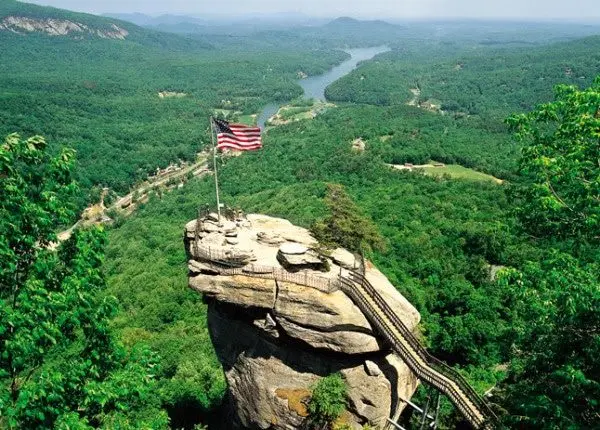
One year ago this week, Hurricane Helene devastated the mountains of western North Carolina, resulting in significant damage to buildings, infrastructure, and natural resources, tragic loss of life, and upending the day-to-day lives of communities across the region. For the N.C. Department of Natural and Cultural Resources, the storm forced the closure of all 18 of the department’s sites in western N.C., with some remaining closed for nearly a year.
Today, all DNCR sites have reopened at least partially, thanks to the hard work and dedication of DNCR employees, state and federal government partners, local leaders and volunteers.
“As we mark one year since Hurricane Helene, we are reminded of both the destruction it caused, and the resilience demonstrated across western North Carolina,” said DNCR Secretary Pamela B. Cashwell. “Communities were deeply affected, yet the dedication of our staff and partners played a critical role in restoring and reopening vital places. This milestone provides an opportunity to reflect on the progress made and emphasizes the ongoing importance of supporting the recovery and vitality of the region. I just spent a week in western North Carolina and encourage people to come and visit!”
Widespread Impact at Western N.C. State Parks, Historic Sites and Museums
Helene caused widespread destruction at state parks in western North Carolina, including uprooted trees, damaged roads, trails and washed-out bridges. The storm caused tens of millions of dollars in damage to state parks and connecting infrastructure. The recovery process involved clearing debris, repairing buildings and infrastructure, and rebuilding roads, bridges and trails.
- Over 150 State Parks staff from across the state assisted in storm response, including as first responders and law enforcement officers. They provided security for shelters and hospitals, performed door-to-door welfare checks, conducted victim rescue and recovery, and supported the multi-agency post-storm response.
- In the aftermath of the storm, all 13 parks west of Interstate 77 were closed, many for extended periods. Three parks remained fully closed at the start of 2025. South Mountains State Park reopened on April 10; Chimney Rock State Park on June 27; and Mount Mitchell State Park on Sept.15.
- Three state historic sites in western North Carolina sustained storm damage – Thomas Wolfe Memorial in Asheville, Vance Birthplace in Weaverville, and Town Creek Indian Mound in Montgomery County. All three were able to reopen before the end of 2024.
- The Mountain Gateway Museum in Old Fort endured devastating damage from Hurricane Helene. Staff salvaged artifacts, relocated exhibits, and continued telling the stories of western North Carolina from a temporary location across the street. The work of the N.C. History Museums shows that even in the face of disaster, history finds a way to be shared.
DNCR Divisions Support Recovery in Arts, Libraries, Natural and Historic Resources
Over the past year, DNCR has provided grant funding, analysis and expertise to assist in the recovery of vital historic records and buildings, rare species and habitats, trails and waterways, libraries, and arts organizations:
- Western N.C. libraries provided vital services like electricity, internet, and FEMA coordination; some also offered childcare, public information, and Starlink for areas without fiber, with library staff assisting patrons during recovery. The State Library of North Carolina awarded $348,212 in Library Services and Technology Act (LSTA) grants to libraries to expand outreach and improve service in areas impacted by Helene.
- The North Carolina Arts Council worked with partners to launch the N.C. Arts Disaster Relief Fund just two days after Hurricane Helene. Nearly $1 million was raised to support more than 1,500 artists and 69 nonprofit arts organizations across 26 disaster-affected counties. In communities like Burnsville, Marshall, Blowing Rock and Asheville, the arts and artists are part of the fabric of the region and a key economic driver. Additionally, the Arts Council organized and awarded grants to localities to promote artists’ markets and festivals, which are key drivers of tourism. From emergency grants to recovery planning, the Arts Council has helped the creative community rebuild and reimagine, proving that art is a vital part of resilience.
- The N.C. Natural Heritage Program and the N.C. Land and Water Fund took action to protect habitats and rare species after Hurricane Helene. A $10 million partnership with the U.S. Forest Service, GIS analysis with Duke University, and restoration projects at 28 sites are helping stabilize stream banks, repair trails, and protect biodiversity. Together, the Natural Heritage Program and the N.C. Land and Water Fund are ensuring that North Carolina’s natural treasures recover and thrive.
- The State Historic Preservation Office and Office of State Archaeology assisted with restoration of historic properties and cemeteries, processed more than 900 required historic preservation reviews, and served as subject matter experts in safeguarding North Carolina’s heritage.
As western North Carolina continues to rebuild, the N.C. Department of Natural and Cultural Resources will maintain its strong commitment to preserving the natural and cultural heritage of the region, while serving as an important driver of tourism and economic recovery. In that spirit, the North Carolina Awards, the state’s highest civilian honor, will be held in Asheville on Nov. 13, with all proceeds going to support western North Carolina recovery. To learn more about DNCR’s Helene recovery story, please visit https://www.dncr.nc.gov/one-
About the North Carolina Department of Natural and Cultural Resources
The N.C. Department of Natural and Cultural Resources (DNCR) manages, promotes, and enhances the things that people love about North Carolina – its diverse arts and culture, rich history, and spectacular natural areas. Through its programs, the department enhances education, stimulates economic development, improves public health, expands accessibility, and strengthens community resiliency.
The department manages over 100 locations across the state, including 27 historic sites, seven history museums, two art museums, five science museums, four aquariums, 35 state parks, four recreation areas, dozens of state trails and natural areas, the North Carolina Zoo, the State Library, the State Archives, the N.C. Arts Council, the African American Heritage Commission, the American Indian Heritage Commission, the State Historic Preservation Office, the Office of State Archaeology, the Highway Historical Markers program, the N.C. Land and Water Fund, and the Natural Heritage Program. For more information, please visit www.dncr.nc.gov.




